Arda Kızıldağ is a 22-year-old academy graduate from relegation-battling Turkish Süper Lig side Gençlerbirliği. He typically plays as a right centre-back in Gençlerbirliği’s 4-2-3-1.
The centre-back, who stands at 187cm (6’2”) tall and weighs 78kg (171lbs), has got just over a year remaining on his contract.
This tactical analysis provides analysis of Kızıldağ’s impressive season as part of a struggling side. This scout report will highlight some of the key strengths and weaknesses of his game and explain why we feel the defender, who’s currently valued at €275k (£236.77k) by Wyscout, could be one to watch as a potential bargain in the summer when his contract is set to enter its final year.
Arda Kızıldağ Style Of Play
Anticipation is a key strength of Arda Kızıldağ’s game. This has helped him to excel in areas such as interceptions this season.
Gençlerbirliği have made the seventh-most interceptions (40.29 per 90) of any Süper Lig side this season, with Kızıldağ making the second-most (6.95 per 90) of any member of Ankara Rüzgârı.
This is also the seventh-most interceptions any player in Turkey’s top-flight has made.
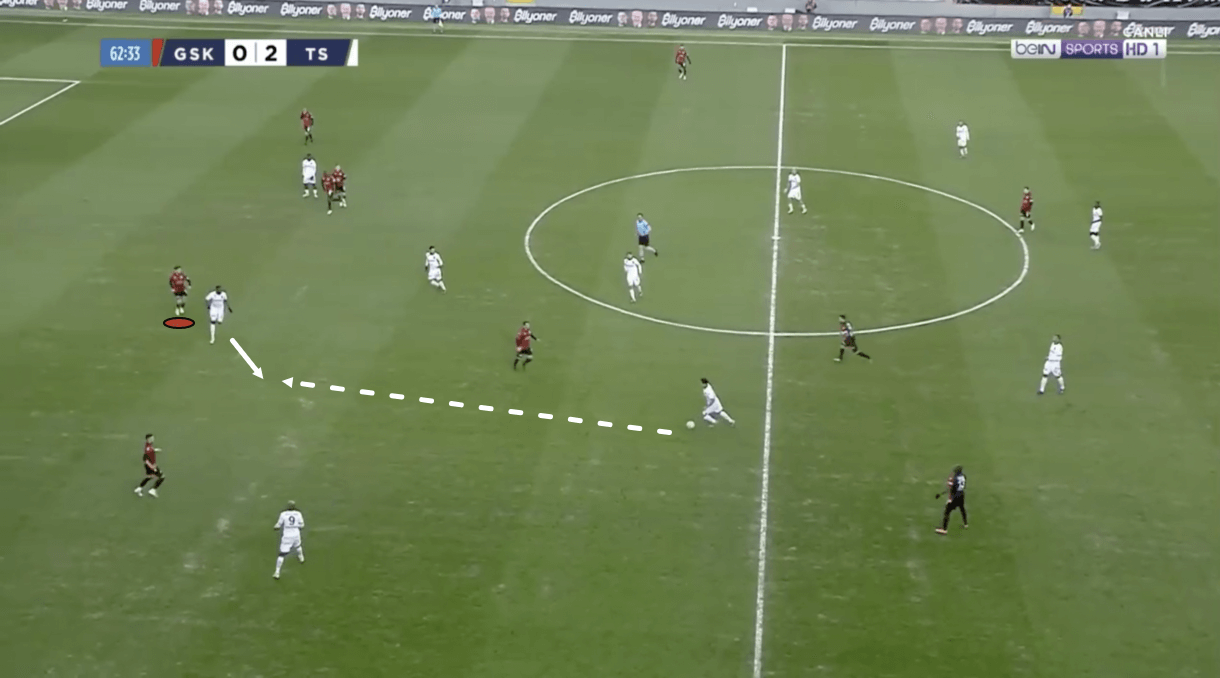
The image shows an example of Kızıldağ’s interception-making ability, aided by his anticipation of the pass from the midfielder on the ball. He does well to spot the impending attempt to progress the ball and anticipate the movement of the striker. This helps him to time his movement and prepare to pull off an interception.
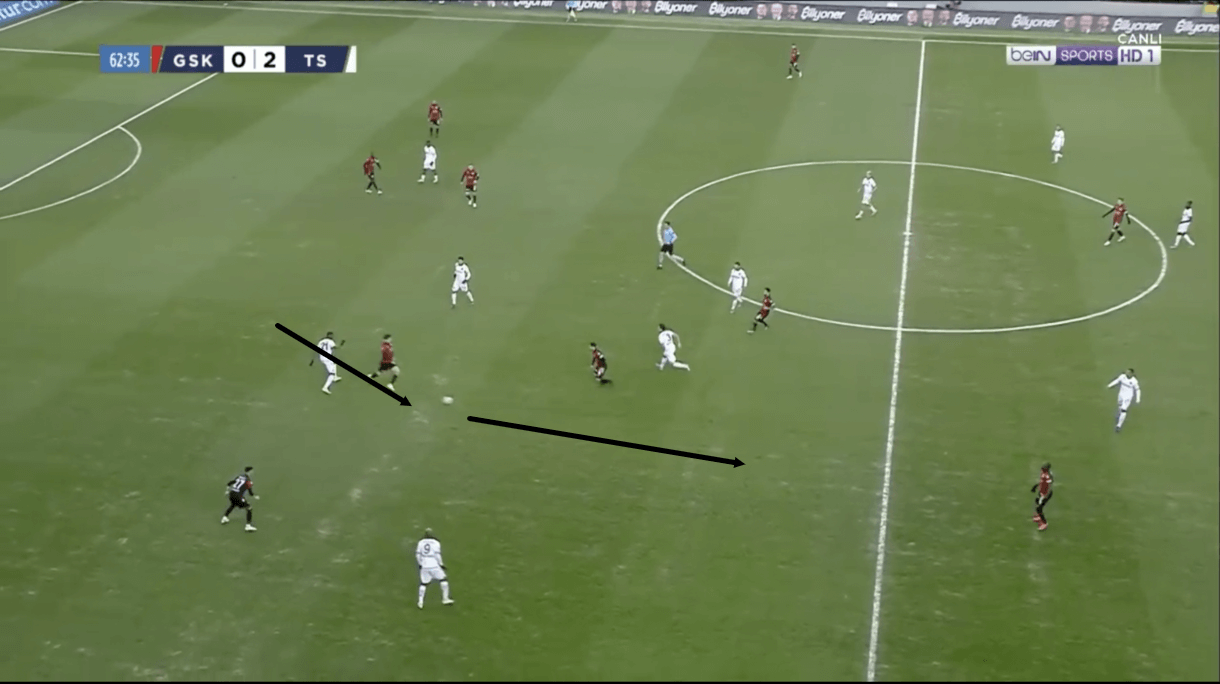
As the play moves on, figure 2 shows us that Kızıldağ ends up racing in front of the intended receiver, making this interception, winning possession back for Gençlerbirliği and carrying the ball upfield before playing a pass to another teammate in a more advanced position.
Kızıldağ’s pace, which we’ll focus on more later on in this scout report, is also important here, as it allows him to bide his time before racing in front of the defender to quickly make this interception. This allows him to pull off a move like this successfully after the pass has been played, effectively luring the opposition into playing the pass as they did before taking back possession.
However, his anticipation of the incoming pass and the movement of the striker allows him to prepare to make this movement and time his run. All of these factors combine to help him succeed to the level he does at making interceptions and it’s clear that anticipation is a big part of that.
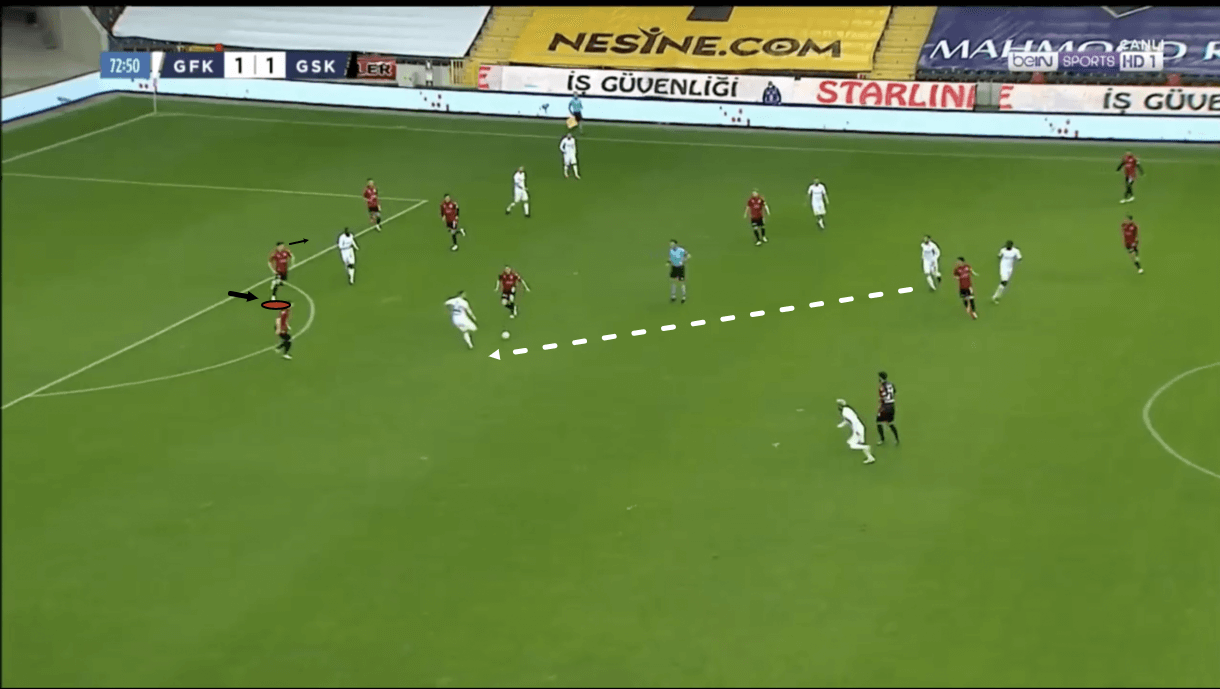
The previous passage of play showed us an example of Kızıldağ making an interception aggressively, in a more advanced area of the pitch. That aggression is another key aspect of his game which we’ll go on to explore in greater detail, however, he doesn’t just make interceptions high up the pitch, he also excels at making interceptions in a similar fashion in deeper positions, like where we see him in the image.
Here, the centre-back is just on the edge of the penalty box, with Gençlerbirliği set up to defend deep at this moment in a very narrow 4-2-3-1 shape.
We can see that one opposition player is just about to receive the ball outside the box here and he’s shaping up to play a first-time pass into the striker positioned right next to Kızıldağ. Even before this player receives the ball, when he’s just shaping up his body to play this pass, Kızıldağ is alert to his intent and he’s already pushing out to get in front of the intended receiver.
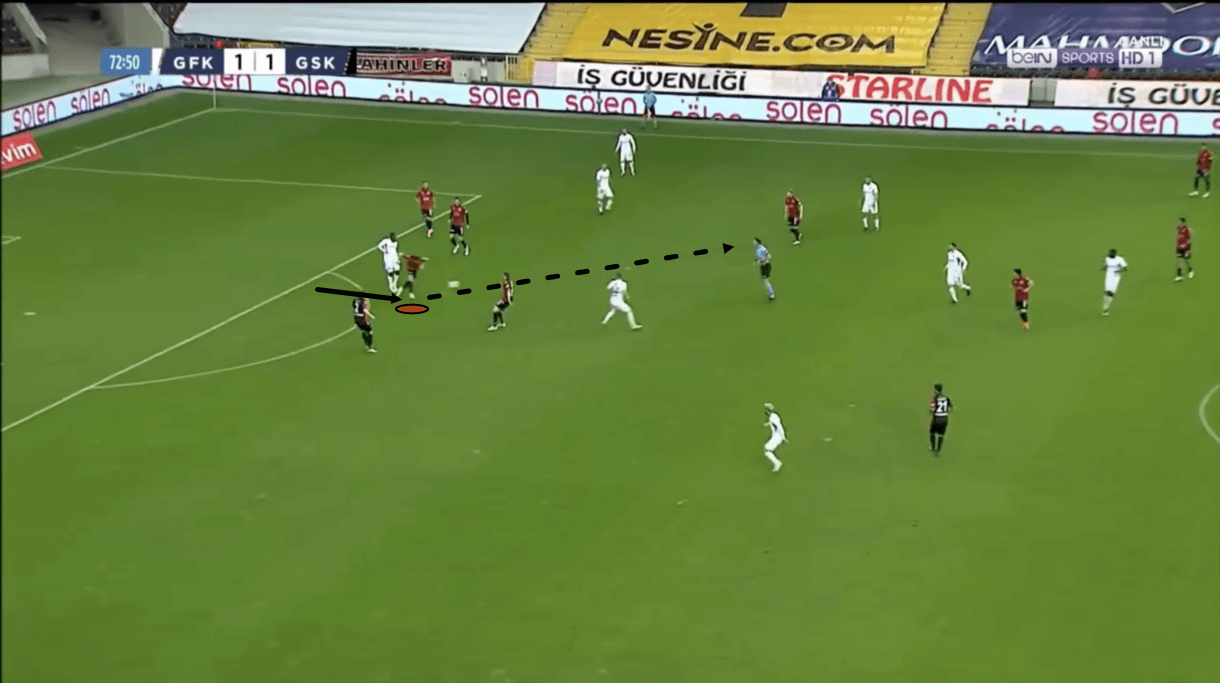
Despite the passer playing the ball first-time, at a significant pace, Kızıldağ’s anticipation helps him to stay one step ahead. By the time the ball gets to the striker’s position, the centre-back can intercept the pass and win back possession for Gençlerbirliği.
This second passage of play may highlight Kızıldağ’s anticipation even more than the first passage of play that we analysed, as the play was moving at a quicker pace and it may have been even less clear that the pass into the striker was coming.
Despite that, Kızıldağ managed to stay alert to the opposition’s intent by closely observing the passer’s body language.
Arda Kızıldağ Aggression
Gençlerbirliği press aggressively in relation to the rest of the Süper Lig. They’ve got the eighth-lowest PPDA (11.85) out of the Süper Lig’s 21 teams. This is lower than the league average of 12.15.
As a result of Gençlerbirliği’s defensive tactics, the full-backs often get drawn high up the pitch, which leads to space opening up behind them on the wing for the opposition to potentially exploit and when teams do attempt to exploit that space, the centre-backs end up moving into higher and/or wider areas to provide cover.
This is a risky strategy, as the centre-backs’ movement, in turn, leads to space opening up in a more central position which the opposition could also exploit via quick passing and movement, which does happen. However, while his team does deploy a risky defensive strategy with some clear weaknesses which may have played a part in their struggles this season, Kızıldağ is comfortable with defending aggressively, either high up the pitch or in wide areas, and often performs well in 1v1 duels.
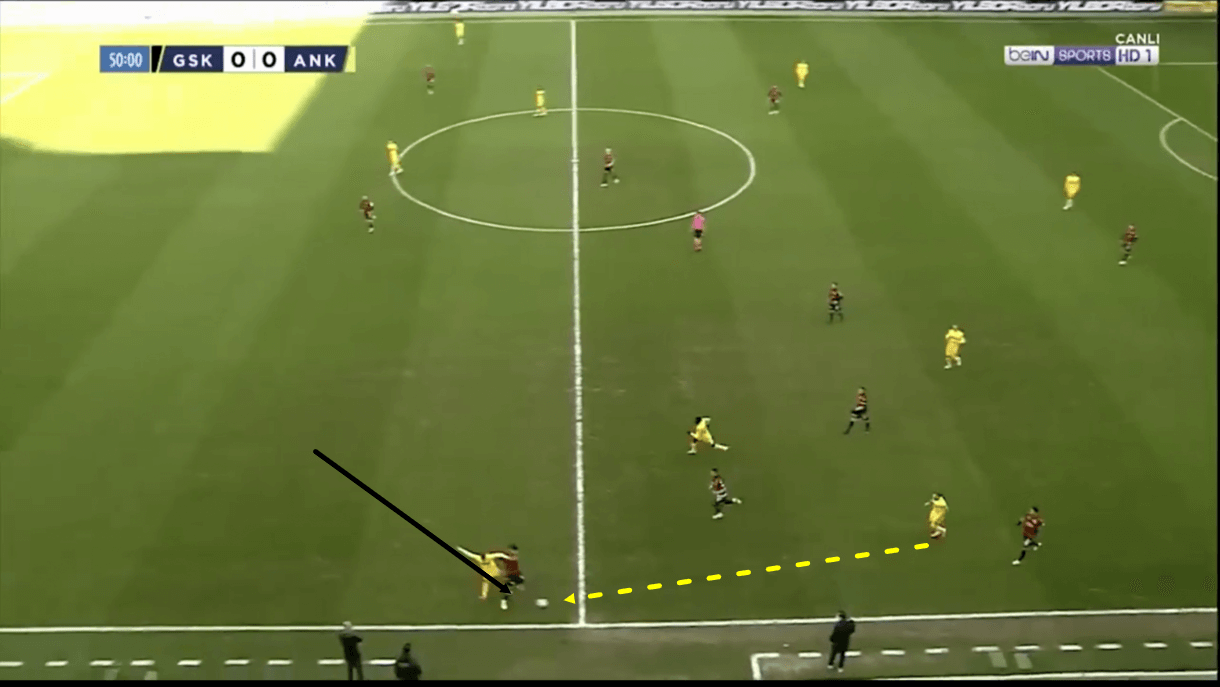
This image shows an example of an occasion where Kızıldağ has been drawn away from his usual centre-back position out to the right-back position, as we just described. An opposition player moved into the space that the right-back vacated and the ball was played towards him.
However, demonstrating his anticipation and pace, as well as his comfortability with defending aggressively, Kızıldağ deals with the danger by running out wide and pulling off an interception.
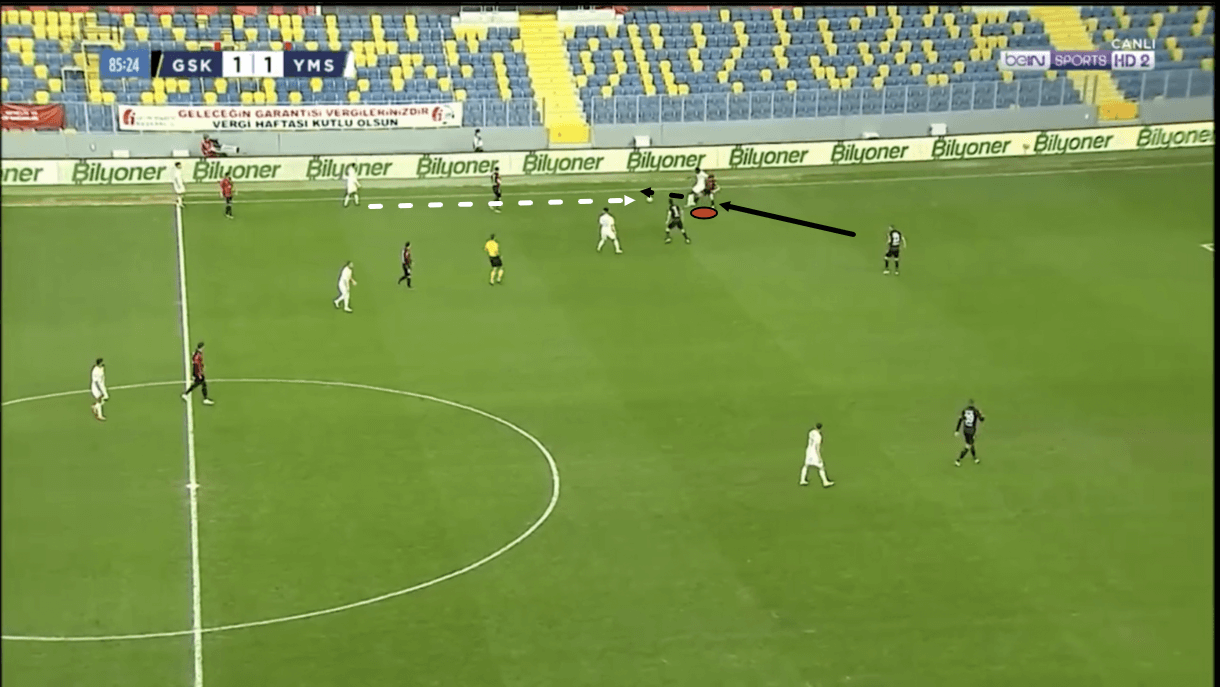
Here, we see another example of Kızıldağ defending out wide, only on this occasion, he performs a well-timed tackle to put a stop to the attack instead of an interception.
Kızıldağ performs defensive actions out wide in deeper positions as well. If the right-back is drawn out of position with Gençlerbirliği defending deeper, an attacker may still run into the space out wide just to the side of the penalty area, which also usually leads to Kızıldağ being dragged out to the wing.
Gençlerbirliği have engaged in 65.11 defensive duels per 90 this season – the third-most of any Süper Lig team – however, they haven’t been very successful with those defensive duels, in general. They’ve got a 58.6% defensive duel success rate, which is greater than just six other Süper Lig teams and lower than the league average of 59.34%.
However, Kızıldağ has got a defensive duel success rate of 60.81%, which is higher than the league average, indicating that he has been performing relatively well in this area, despite his team’s overall struggles in defensive duels.
So, Kızıldağ performs relatively well in this system that sees Gençlerbirliği press aggressively and perform lots of defensive actions.
Kızıldağ tends to come out on top in 1v1 defensive duels that are contested at relatively low pace, though he struggles more in fast-paced 1v1 duels.
If a player has space and time to build up speed before dribbling towards him, there’s a good chance he will not come out of the defensive duel successfully because of how aggressive he tends to be when engaging an opposition player. Good dribblers moving at a fast pace are often able to anticipate his aggressive challenges and skip past him, or at least move the ball out of the firing line and draw a foul.
If play isn’t already moving at a fast pace, though, Kızıldağ has shown to be well capable of reading attackers’ movement and winning back the ball. He finds himself in these types of situations more often than not, which perhaps explains why his defensive duel success rate is positive.
Kızıldağ is good at using his relatively large frame and impressive strength to shield the ball from an opposition attacker and shepherd it out of play or at least allow a teammate time to clean up. This is because he is very strong. Attackers often find it difficult to win a duel that sees them back into him or go shoulder-to-shoulder with him.
Some notable weaknesses are evident in Kızıldağ’s game resulting from his aggression. He lacks patience at times and this, combined with his aggression, sees him often flying into challenges at full throttle. So, when he fails to win the ball, he can be left for dust by the opposition. This is particularly dangerous because of the space that’s often left open centrally when he advances to engage in a challenge.
If an opposition ball-carrier is aware of Kızıldağ’s tendency to enter challenges aggressively and anticipates this when he drags him out of position, he can play the ball around him, either via passes or a dribble, exploiting the somewhat reckless nature of his playing style and the space it leaves open at the back.
Additionally, Kızıldağ has been too quick to depart from his deep position and press aggressively sometimes, essentially allowing the opposition to react to his movement and catch him out of position. Again, due to the space his movement opens up in the backline, this can be dangerous for Gençlerbirliği.
Cover
Kızıldağ is also an asset thanks to his ability to provide cover in deep areas behind the rest of the backline. This area of his game depends on his anticipation to an extent, but also his pace, which is another big plus to his game.
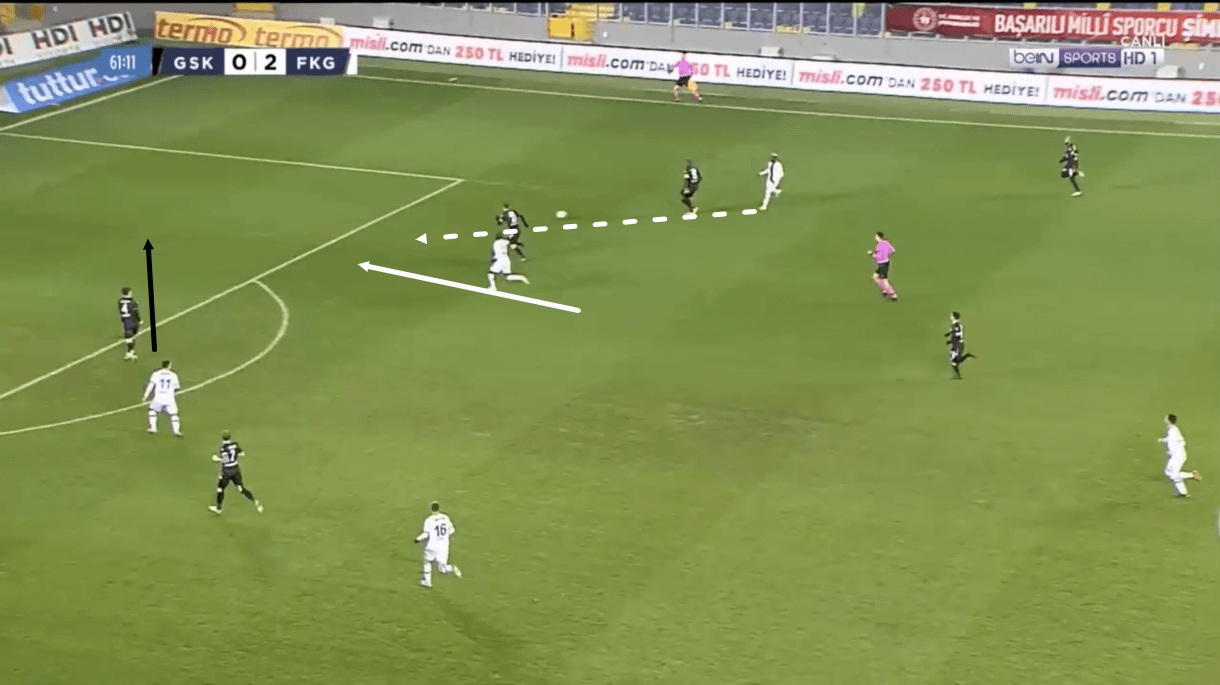
In this example, Kızıldağ’s central defensive partner has ended up on the wrong side of the opposition attacker as he’s played through on goal. With the attacker set to get onto the end of a through ball that will leave him in a 1v1 versus the Gençlerbirliği goalkeeper, Kızıldağ opts to shift over to the left side of the defence to provide cover and attempt to win the ball back.
This move is a big gamble as if the attacker who’s running to get onto the end of the through ball beats Kızıldağ to it, then he can square it and give his teammate in the box, who Kızıldağ has vacated, a good goalscoring opportunity.
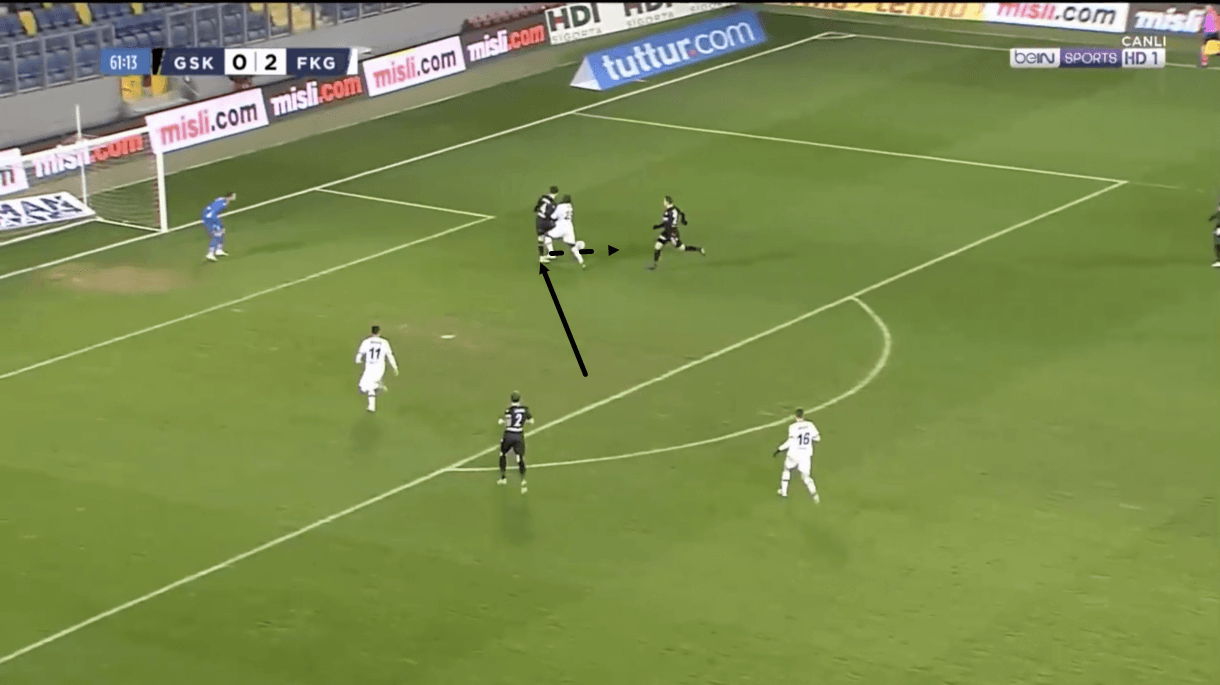
As we can see here, though, Kızıldağ ultimately made a good decision. He was quick enough to make it to the ball first, sweeping up just in front of the six-yard box and clearing the danger.
This shows how risk-taking is a common theme of Kızıldağ’s game, as well as, yet again, how key Kızıldağ’s anticipation can be. However, this passage of play also shows us how important the 22-year-old’s recovery pace is in helping him to make up ground in situations like this. His pace has come in clutch for Gençlerbirliği on several occasions like this during the 2020/21 campaign.
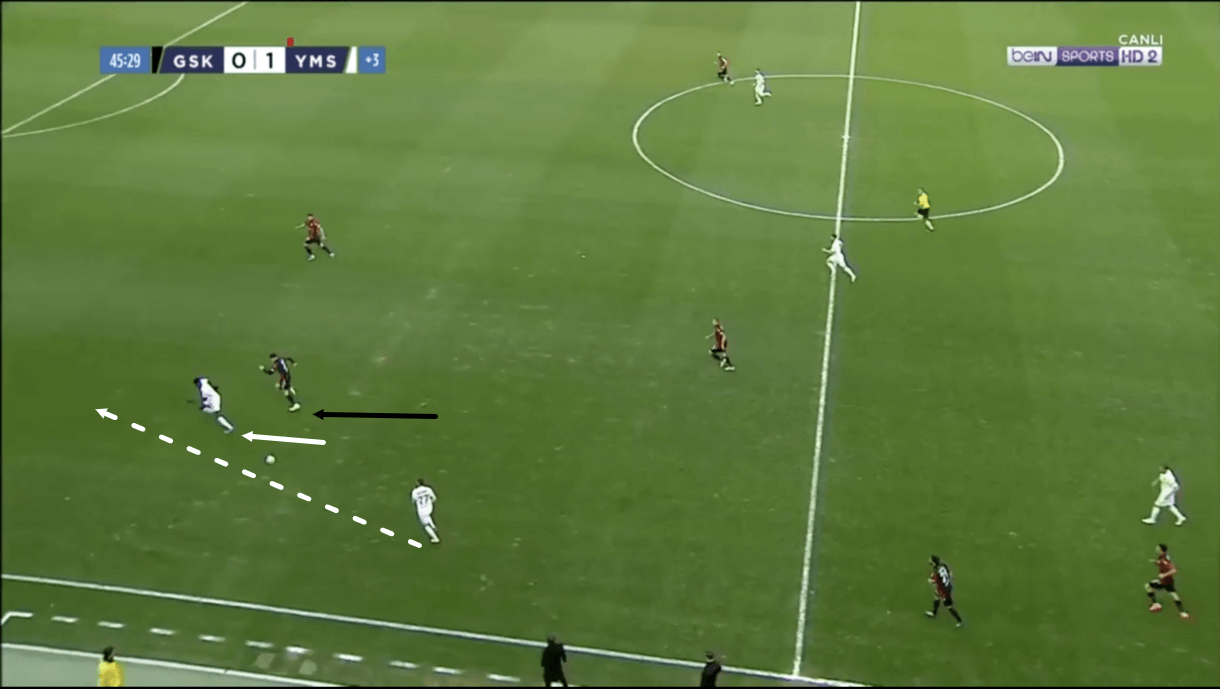
Here, we see the opposition trying to exploit space behind the backline via this through ball and run. With this ball getting played along the opposite side of the attacker to Kızıldağ, he’s unable to pull off an interception here and instead must chase the attacker.
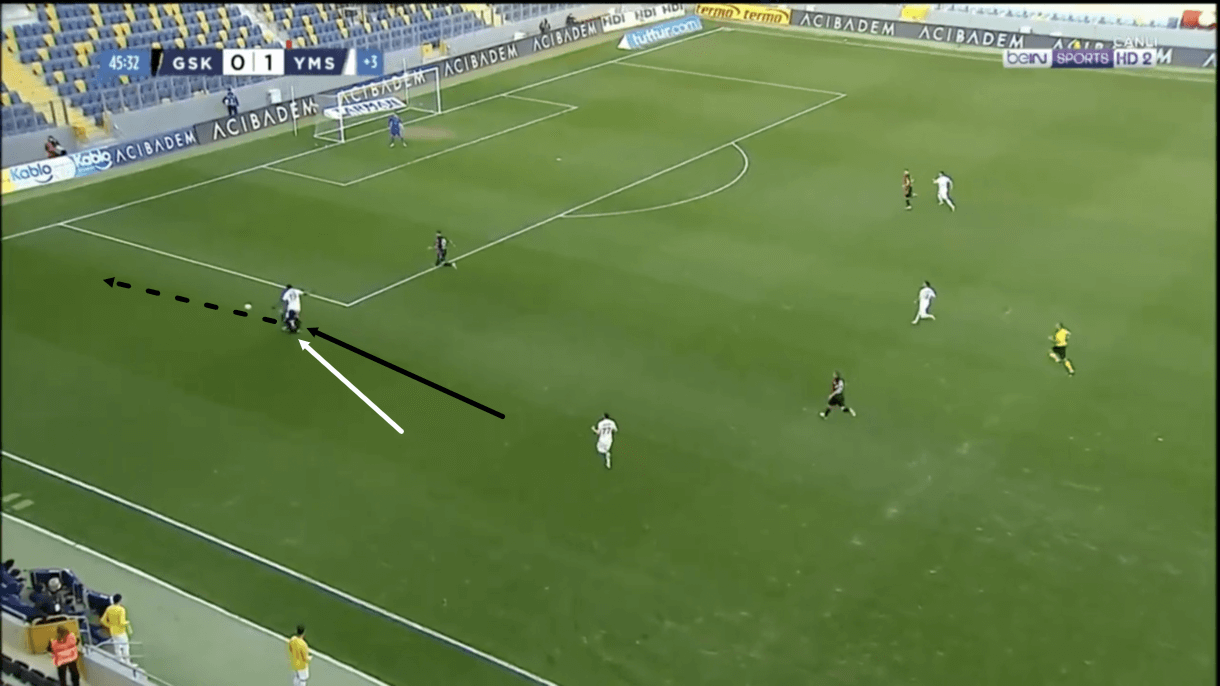
Fortunately for Kızıldağ and Gençlerbirliği, he was quick enough to recover and by the time the attacker reached the edge of Gençlerbirliği’s penalty box, Kızıldağ was in position to perform a sliding tackle, putting a stop to the attack and sending the ball out of play, averting what could have been a very dangerous scenario.
This, again, provides an example of how Kızıldağ’s pace has proven crucial for Ankara Rüzgârı at times this term. He’s been capable of keeping up with the majority of attackers he’s come up against when they’ve been able to run in behind against him, which has been a big help to Gençlerbirliği’s defensive efforts, especially when they defend as aggressively as they do, leading to the backline being positioned quite high a lot of the time. Kızıldağ is well-suited to defending in this system.
Sliding tackles like this aren’t a very common part of Kızıldağ’s game, but as we saw here, he’s comfortable using them when he feels it’s necessary. Like when he pushes high up the pitch, Kızıldağ’s slide tackling is high-risk and can lead to him getting caught out of position, but he’s generally quite calculated in terms of when he slides in, even if he does defend too aggressively on occasion.
Arda Kızıldağ Heading
Gençlerbirliği, in general, haven’t been very good in the air this term. They’ve engaged in fewer aerial duels (29.94) than any other Süper Lig side, while they’ve got the second-worst aerial duel success rate in the Süper Lig (42.7%).
Kızıldağ, however, has performed very well in this area despite his team’s struggles, overall, in the air. The 22-year-old has 5.68 aerial duels per 90, with a 67.86% success rate – the 10th-best aerial duel success rate of anyone in Turkey’s top-flight.
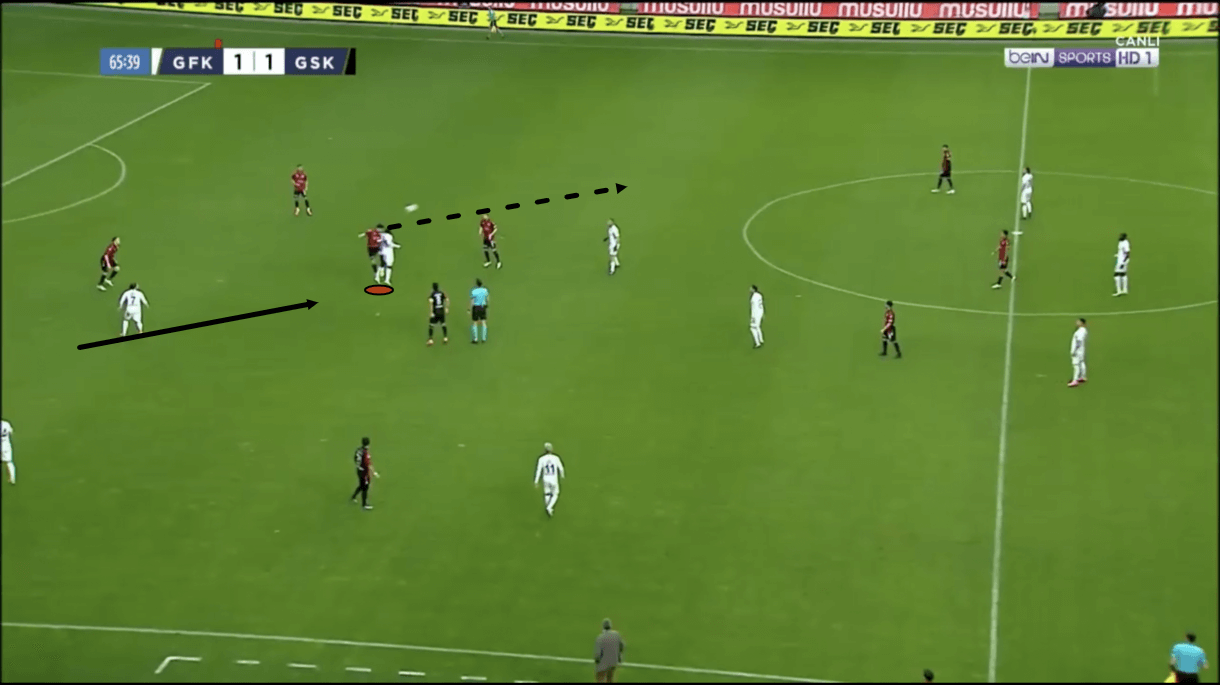
Due to his ability in the air, Kızıldağ is often tasked with contesting aerial duels following an opposition goal-kick even if this requires him to move out of the backline to a more advanced position. This can create space in the backline, should the opposition attacker win the aerial duel and not Kızıldağ, but as the stats show, he’s very reliable in the air as far as any Süper Lig player is concerned, especially for a Gençlerbirliği player, so perhaps it’s understandable why Gençlerbirliği have Kızıldağ contest the aerial duels where possible.
The centre-back is good at contesting aerial duels inside the penalty box too. He’s got a good jumping reach, generally good positioning and he’s very strong, so he’s not someone who teams will get much joy out of targeting via long balls or crosses. He’s a difficult defender to contest duels with.
Kızıldağ’s quality in the air also adds another element to his interception-making ability. Coupled with his anticipation, Kızıldağ’s aerial ability helps him to intercept lofted through balls. This has proven useful for Gençlerbirliği when their backline is positioned high and the opposition are trying to exploit space behind their backline. Kızıldağ’s presence has cut out lofted through ball attempts in this way on several occasions.
Arda Kızıldağ Passing
Lastly, we’ll take a look at Kızıldağ’s ability on the ball. The 22-year-old isn’t a major playmaker for Gençlerbirliği and his central defensive partners, as well as the holding midfield duo in front of them, tend to play a far bigger role than him in ball progression and playmaking from deep.
He is capable on the ball but Gençlerbirliği generally don’t ask a lot of him in this respect, so it may be fair to say that he provides far more off the ball, via his defensive contribution than he does on the ball.
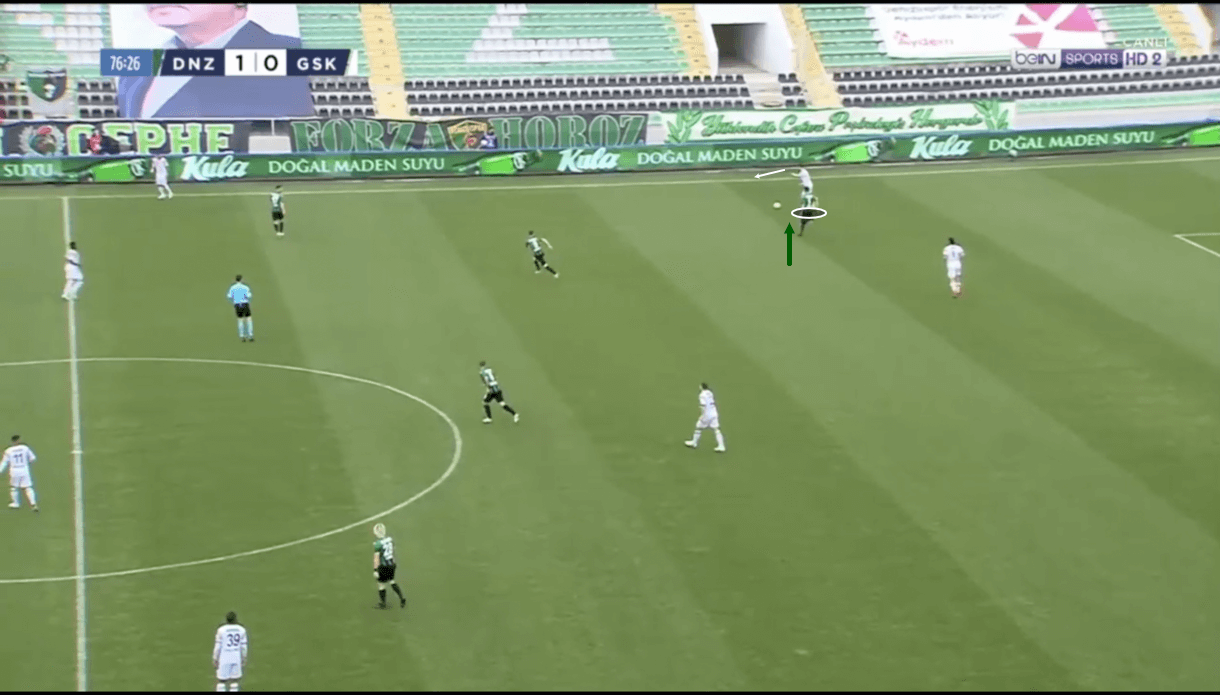
The previous image shows an example of one occasion where Kızıldağ did play a long ball towards a teammate in space. We can see him positioned out wide at the right-back position here while the opposition centre-forward is closing him down, however, this player isn’t closing him down quickly enough to prevent him from getting the ball out of his feet and accurately picking out his teammate.
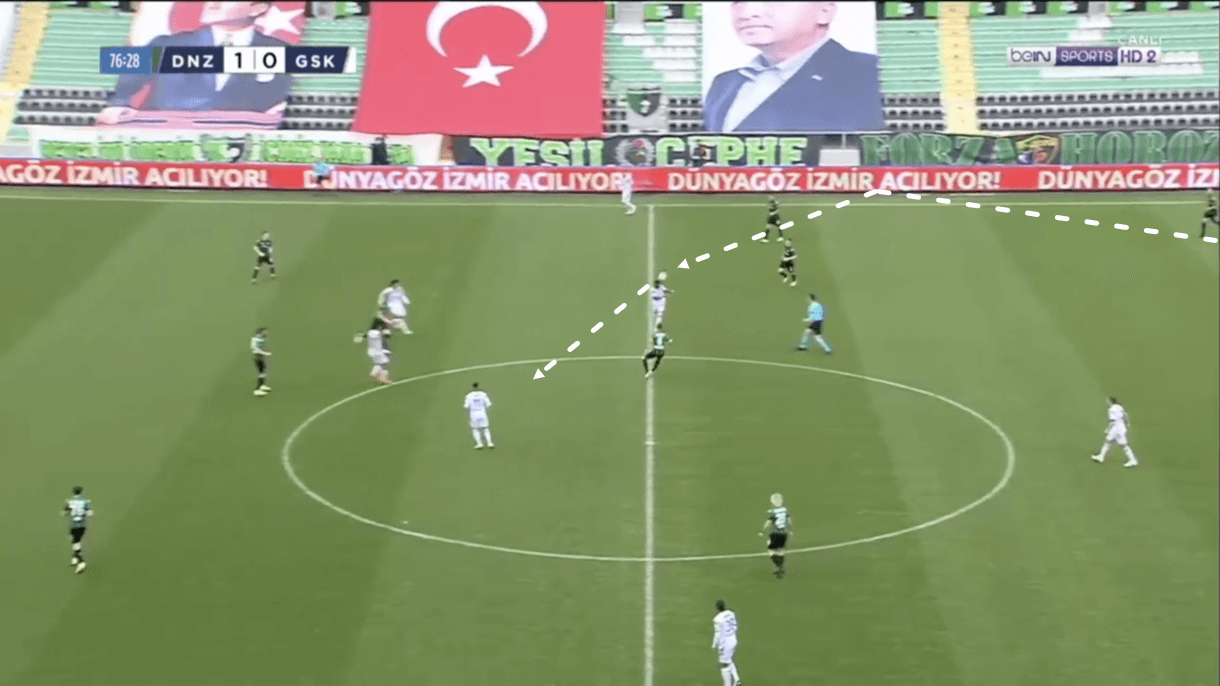
We can see that as the play moves on, Kızıldağ was able to find a midfielder on the halfway line, who got onto the end of his accurate long ball and headed it onto a Gençlerbirliği attacker.
This long ball was successful because Kızıldağ enjoyed a lot of time to pick out his teammate, who was also in a lot of space.
While the centre-back was being closed down in Figure 12, he had plenty of time on the ball before the player got to him, and he used up all of it, drawing the opposition player close before sending the ball forward.
The pass was accurate, and I found the teammate, who was not under much pressure at all.
So, this passage of play demonstrates the point that Kızıldağ hasn’t got many issues with playing fairly simple balls, be they short or long passes, to advance the play, provided there isn’t much pressure on him.
However, his ability on the ball is an area in which he could do with some improvement.
He struggles under pressure a lot of the time.
Suppose the opposition presses him significantly and doesn’t allow him much time on the ball to settle himself and pick out his pass.
In that case, it’s not uncommon to see him misplacing passes like the one he played in the previous passage of play by either misdirecting the pass or over/under-hitting the pass.
As a result, Kızıldağ’s long-passing is generally restricted to low-risk balls to minimise the likelihood of the opposition capitalising on his limitations in this area.
Conclusion
To conclude our tactical analysis, we feel it’s safe to say that Kızıldağ has been one of few bright sparks for Gençlerbirliği this season.
He’s performed very well in several areas, standing out in terms of his aerial ability, ability to read the game and his ability to effectively defend aggressively.
His aggression can lead to him getting caught out at times, he could benefit from improving his patience, he is, at times, a very emotional player, which may not be the trait that you always want in your centre-back and he has limitations on the ball, however, despite their poor season overall, Gençlerbirliği have done a good job at highlighting Kızıldağ’s strengths and minimising the impact of his weaknesses.
Suppose Wyscout’s €275k valuation of the centre-back is accurate to what it may cost to prise Kızıldağ from Ankara Rüzgârı in the summer, with the 22-year-old entering the final year of his contract and Gençlerbirliği looking likely to suffer relegation.
In that case, we feel teams competing far higher up the table in the Süper Lig or, perhaps, teams competing at the lower end of one of Europe’s more traditionally prestigious leagues, such as Ligue 1, Serie A or the Bundesliga, could be wise to keep this potential bargain in mind, as he has been one of the most impressive young players in his position in the Süper Lig this season.

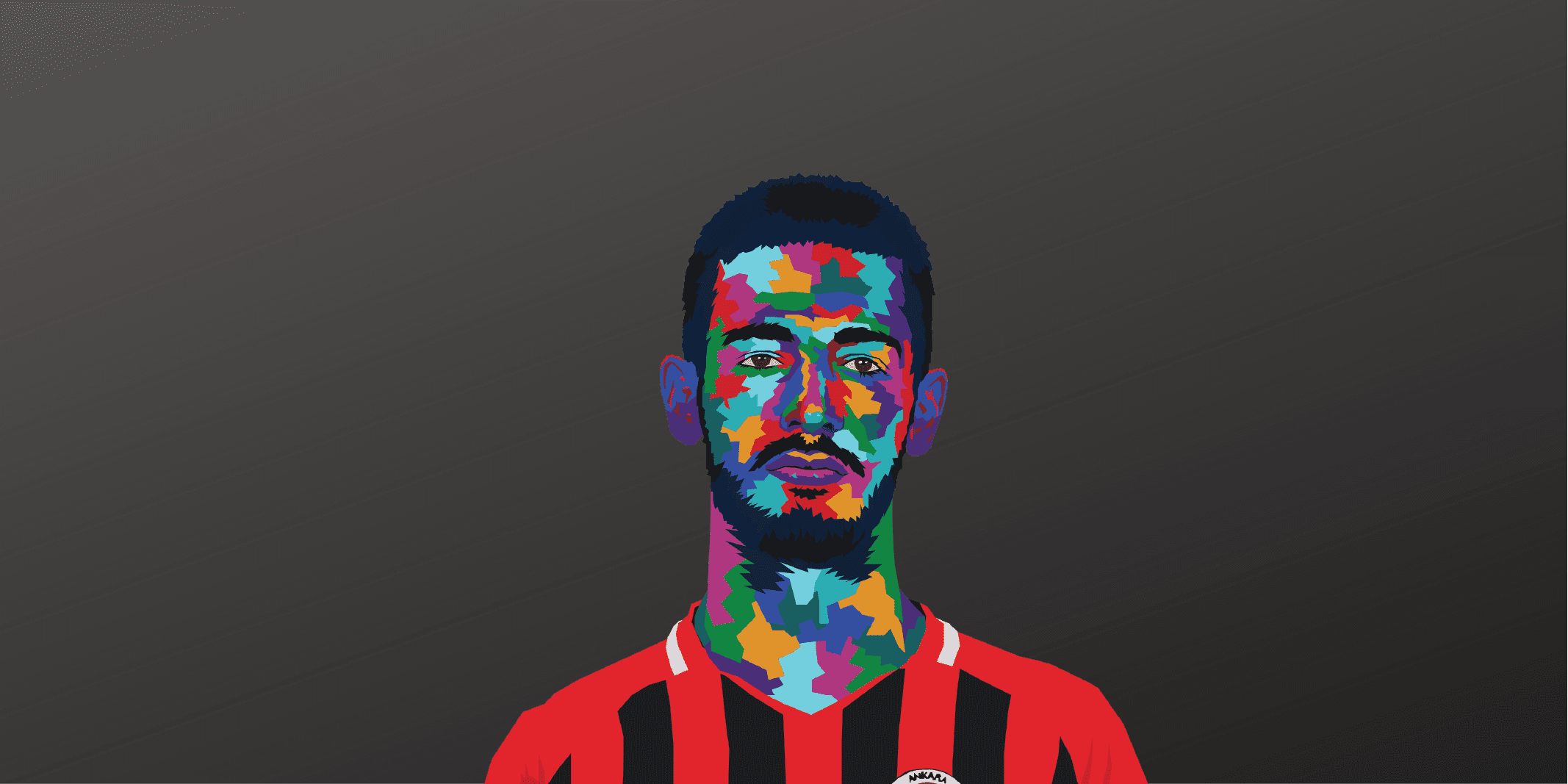
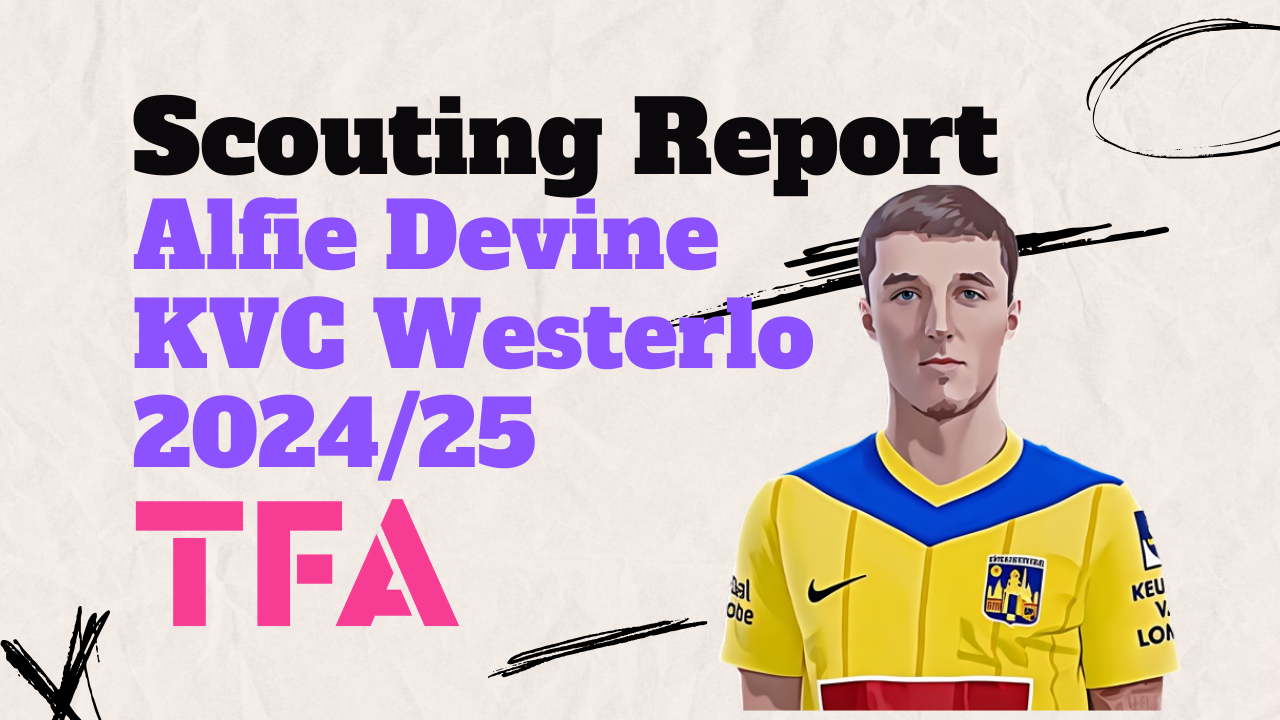
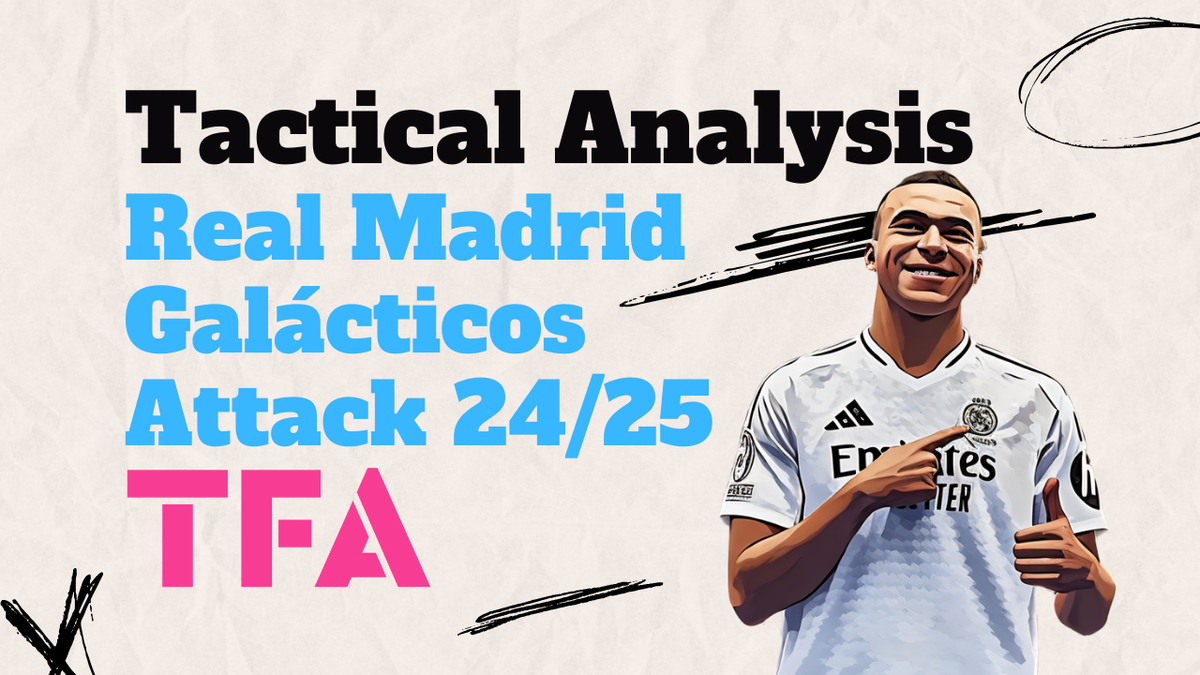
Comments